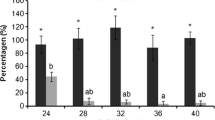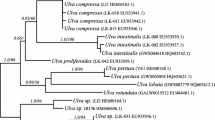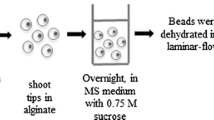Abstract
The development of methods for long-term storage of microalgae remains an important and complex problem, the solution of which is impossible without studying the processes occurring during dehydration and rehydration of vegetative cells. The study presents the results from the investigation of changes in the dimensional characteristics of cells and trichomes of spirulina Arthrospira (Spirulina) platensis (Nordstedt) Gomont after dehydration and during reactivation (in dynamics) as well as processes occurring in them during reactivation. Methods close to natural dehydration were selected. Morphometric measurements of cells and trichomes of spirulina in their native state and during dehydration and rehydration were performed. Dehydration of A. platensis was accompanied by statistically significant changes in the morphometric characteristics of cells. For all methods of dehydration (in a thermostat at 30 and 60°C and on silica gel in a desiccator at a room temperature of 20°C) a decrease in their size, as well as elongation and flattening, were noted. The thickness and volume of trichomes after dehydration were reduced by two times. All processes occurring during reactivation were traced in dynamics, from the moment of moistening to the appearance of young threads. A relatively rapid flooding of the dried cells and a gradual restoration of their morphometric characteristics was noted. Among the reactivating trichomes, those in which the separation into viable and irreversibly areas damaged was clearly visible were found. Differential staining of trichomes with methylene blue revealed cells with strong plasmolysis inside externally intact threads. Morphometric parameters of the spirulina cell were restored within 24 h. This fact indicates that, in dehydrated cultures after rehydration, a number of complex biochemical processes occur, due to which the initial physiological state of the cells is restored.





Similar content being viewed by others
REFERENCES
Fu, N. and Chen, X.D., Towards a maximal cell survival in convective thermal drying processes, Food Res. Int., 2011, vol. 44, p. 1127. https://doi.org/10.1016/j.biortech.2014.10.139
Show, K.Y., Lee, D.J., Tay, J.H., Lee, T.M., and Chang, J.S., Microalgal drying and cell disruption—rec-ent advances, Bioresource Technol., 2015, vol. 184, p. 258. https://doi.org/10.1016/j.biortech.2014.10.139
Hosseinizand, H., Drying and co-pelletization of microalgae with sawdust, PhD Thesis, Vancouver: Univ. British Columbia, Chem. Biol. Engineer., 2018.
Duygu, D.Y., Udoh, A.U., Özer, T., and Erkaya, I.A., The characteristics and importance of microalgae culture collections, Süleyman Demirel Üniv. Eğirdir, Ürünleri Fakültesi Dergisi, 2017, vol. 13, p. 80.
Nugroho, W.S.K., Kim, D.A., Kim, D.W., Koo, B.W., Hur, Y.B., and Kim, H.J., Current advances in cryopreservation of microalgae, J. Mar. Life Sci., 2016, vol. 1, p. 70. http://jmls.or.kr
Lin, L.P., Microstructure of spray-dried and freeze-dried microalgal powders, Food Structure, 1985, vol. 4: 17. https://digitalcommons.usu.edu/foodmicrostructure/ vol4/iss2/17
Crowe, J.H., Hoekstra, F.A., and Crowe, L.M., Anhydrobiosis, Annu. Rev. Physiol., 1992, vol. 54, p. 579.
Park, H.K., Long-term preservation of bloom-forming cyanobacteria by cryopreservation, Algae, 2006, vol. 21, p. 125.
Sidyakina, T.M., Preservation of microorganisms in cultural collections, in Konservatsiya geneticheskikh re-sursov (Genetic Resources Conservation), Pushchino: ONTI NTsBI, 1991, p. 81.
Stock, W., Pinsee, E., Decker, S.D., Sefbom, J., Blommaert, L., Chepurnova, O., Sabbe, K., and Vyverman, W., Expanding the toolbox for cryopreservation of marine and freshwater diatoms, Sci. Rep., 2018, vol. 8, p. 4279. https://doi.org/10.1038/s41598-018-22460-0
Day, J.G. and Fleck, R.A., Cryo-injury in algae and the implications this has to the conservation of micro-algae, Microalgae Biotechnol., 2015, vol. 1, p. 1. https://doi.org/10.1515/micbi-2015-0001
Maršálek, B., Rojíčková-Padrtová, R., and Lykavský, J., Long-term maintenance of alga strains for use in biom assays and biotechnology, Algol. Stud.,Arch. Hydrobiol., 1998, suppl. vol. 89, p. 121. https://doi.org/10.1127/algol_stud/89/1998/121
Lorenz, M., Friedl, T., and Day, J.G., Perpetual maintenance of actively metabolizing microalgal cultures, in Algal Culturing Techniques, Andersen, R.A., Ed., New York: Academic, 2005, p. 145.
Bewley, J.D., Physiological aspects of desiccation tolerance, Annu. Rev. Plant Physiol., 1979, vol. 30, p. 195.
Nesterenko, T.V. and Kuz’mina, R.I., Reactivation of microalgae from dry anabiosis condition, in Voprosy upravleniya biosintezom nizshikh rastenii (Biosynthesis Management Issues for the Lower Plants), Terskov, I.A., Ed., Novosibirsk: Nauka, 1982, p. 139.
Kuz'mina, R.I., Algae anabiosis study, Algologiya, 1992, vol. 3, p. 15.
Day, J.G., Watanabe, M.M., Morris, G.J., Fleck, R.A., and McLellan, M.R., Long-term viability of preserved eukaryotic alga, J. Appl. Phycol., 1997, vol. 9, p. 121.
Holzinger, A. and Karsten, U., Desiccation stress and tolerance in green algae: consequences for ultrastructure, physiological, and molecular mechanisms, Front. Plant Sci., 2013, vol. 4, p. 327. https://doi.org/10.3389/fpls.2013.00327
Beker, M.E., Damberg, B.E., and Rapoport, A.I., Anabioz mikroorganizmov (Anabiosis of Microorganisms), Riga: Zinatne, 1981.
Rozenfelde, L. and Rapoport, A.I., Anhydrobiosis in yeast: is it possible to reach anhydrobiosis for yeast grown in conditions with severe oxygen limitation? Antoni-e van Leeuwenhoek, 2014, vol. 106, p. 211.
Faucher, O., Coupal, B., and Leduy, A., Utilization of scawater—urea as a culture medium for Spirulina maxima,Can. J. Microbiol., 1979, vol. 25, p. 752.
Metody fiziologo-biokhimicheskogo issledovaniya vodoroslei v gidrobiologicheskoi praktike (Methods for Physiological and Biochemical Study of Algae in Hydrobiological Practice), Sirenko, L.A., Ed., Kiev: Nauk. Dumka, 1975.
Rovenskii, Yu.A., Rastrovaya elektronnaya mikroskopiya normal’nykh i opukholevykh kletok (Scanning Electron Microscopy of Normal and Tumour Cells), Moscow: Meditsina, 1979.
Bryantseva, Yu.V., Shape index of unicellular microalgae as a new morphometric criterion, Ekol. Morya, 2005, no. 67, p. 27.
Bryantseva, Yu.V., Lyakh, A.P., and Sergeeva, A.V., Calculation of Volumes and Surface Areas of Unicellular Algae in the Black Sea, Preprint Nats. Akad. Nauk Ukrainy, 2005.
França, M.B., Panek, A.D., and Eleutherio, E.C.A., Oxidative stress and its effects during dehydration, Comp. Biochem. Physiol., 2007, vol. 146, p. 621.
Tomasseli, L., Morphology, ultrastructure and taxonomy of Arthrospira (Spirulina) maxima and Arthrospira (Spirulina) platensis, in Spirulina platensis (Arthrospira): Physiology, Cell-Biology and Biotechnology, Vonshak, A., Ed., London: Taylor & Francis, 1997, p. 1.
Kapoore, R.V., Huete-Ortega, M., Day, J.D., Okurowska, K., Slocombe, S.P., Stanley, M.S., and Vaidyanathan, S., Effects of cryopreservation on viability and functional stability of an industrially relevant alga, Sci. Rep., 2019, vol. 9, p. 2093. https://doi.org/10.1038/s41598-019-38588-6
Kröger, M., Klemm, M., and Nelles, V., Extraction behavior of different conditioned S. rubescens,Energies, 2019, vol. 12, p. 1336. https://doi.org/10.3390/en12071336
Tsutsaeva, A.A., Balyberdina, L.M., Ananyna, A.E., and Grisha, I.G., Cryopreservation of Spirulina platensis culture, Probl. Cryobiol. Cryomed., 2007, vol. 17, p. 168.
Funding
The study was prepared on the topic of the state assignment of Kovalevsky Institute of Biology of the Southern Seas, Russian Academy of Sciences, “Study of the Mechanisms for Controlling Production Processes in Biotechnological Complexes for Development of the Scientific Foundations for the Production of Biologically Active Substances and Technical Products of Marine Genesis” (project no. AAAA-A18-118021350003-6).
Author information
Authors and Affiliations
Corresponding author
Ethics declarations
The authors declare that they have no conflict of interest. This article does not contain any studies involving animals or human participants performed by any of the authors.
Additional information
Translated by V. Mittova
Rights and permissions
About this article
Cite this article
Kharchuk, I.A. Changes in Morphometric Indices of Arthrospira (Spirulina) platensis Cells and Trichomes during Dehydration and the Reactivation Period. Russ J Plant Physiol 67, 680–689 (2020). https://doi.org/10.1134/S1021443720030152
Received:
Revised:
Accepted:
Published:
Issue Date:
DOI: https://doi.org/10.1134/S1021443720030152




